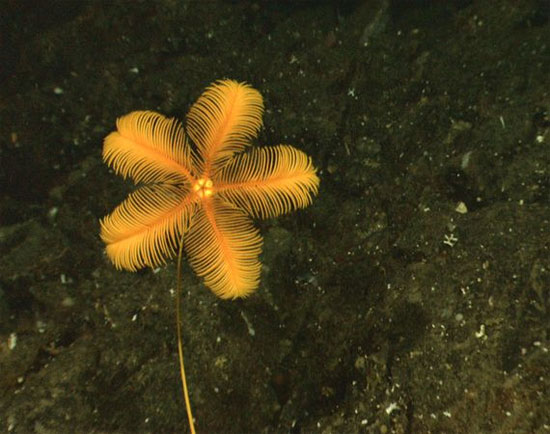Detecting Hue Bien fossils on Dong Van stone plateau
During the survey to develop the development plan of the Geopark, Professor Autur Sa of Trás-os-Montes e Alto Douro Portugal discovered Hue Bien fossil in the area of Chin Don Phin village, Lung commune Pu, Meo Vac district.

The fossil site is located on the road from Meo Vac district to Khau Vai, 2km from Lung Pu commune headquarters.The Hue Sea fossil was discovered to be large in size, the density is thicker than other Hue Bien fossils in the park area. The Hue Bien fossil was found to enrich the geological heritage list on Dong Van Rock Plateau Geopark.
Sea lilies (Endoxocrinus parrae) bear this name because they resemble a flower that hangs on the ocean floor. However, according to US researchers, this is a echinoderm similar to sea urchins, capable of fleeing before the threat.
They are the oldest group of echinoderms that still exist today, with about 5000 fossils and more than 600 species living. Most sea lilies live with long stalks, a few live freely. Today people rarely see sea lilies, even though they once dominated the ocean floor.
- Go to Dong Van stone plateau to see the gray paradise
- Remnants of prehistoric people at Dong Van stone plateau
- Invaluable heritage on Dong Van plateau
- Detecting many archaeological relics in Dong Van stone plateau
- Found stone tools dating from 10,000-30,000 years
- Dong Van stone plateau becomes a world geopark
- Safe vegetables grow well on the stone plateau
- Unique architecture of the Cat mansion
- Discover the oldest fossil fossil in Tibet
- Ha Giang is brilliant in the flower triangle circuit
- Time stamp on Long Bien bridge
- Nearly 170,000 people escape the risk of exposure to dioxin
 Discovered an ancient centipede fossil 99 million years old
Discovered an ancient centipede fossil 99 million years old Discovered bat-like dinosaurs in China
Discovered bat-like dinosaurs in China Discovered a 200-year-old bronze cannon of the coast
Discovered a 200-year-old bronze cannon of the coast Discover 305 million-year-old spider fossils
Discover 305 million-year-old spider fossils